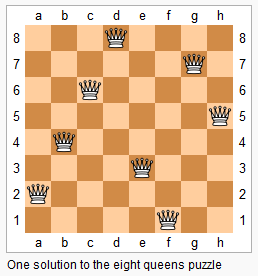N-Queens I
The n-queens puzzle is the problem of placing n queens on an n×n chessboard such that no two queens attack each other.

Given an integer n, return all distinct solutions to the n-queens puzzle.
Each solution contains a distinct board configuration of the n-queens' placement, where 'Q' and '.' both indicate a queen and an empty space respectively.
For example,
There exist two distinct solutions to the 4-queens puzzle:
[ [".Q..", // Solution 1 "...Q", "Q...", "..Q."], ["..Q.", // Solution 2 "Q...", "...Q", ".Q.."] ]
Wiki:任两个皇后都不能处于同一条横行、纵行或斜线上。八皇后问题可以推广为更一般的n皇后摆放问题:这时棋盘的大小变为n×n,而皇后个数也变成n。当且仅当 n = 1 或 n ≥ 4 时问题有解。
回溯,用了一个数组col[i]来表示第i列是不是已经放了queen。
对于(row1, col1)和(row2, col2)这两个位置,如果它们在同一对角线上,那么有abs(row1-row2) = abs(col1-col2)。
class Solution { public: vector<vector<string> > solveNQueens(int n) { if (n == 2 || n == 3) { return ret; } vector<string> sol(n, string(n, '.')); vector<bool> col(n, false); bt(n, 0, col, sol); return ret; } void bt(int n, int r, vector<bool> &col, vector<string> &sol) { if (r >= n) { ret.push_back(sol); return; } for (int i = 0; i < n; ++i) { if (col[i]) continue; bool diag = false; for (int j = r - 1; j >= 0; --j) { for (int m = 0; m < n; ++m) { if (abs(j - r) == abs(m - i) && sol[j][m] == 'Q') { diag = true; break; } } } if (!diag) { col[i] = true; sol[r][i] = 'Q'; bt(n, r + 1, col, sol); col[i] = false; sol[r][i] = '.'; } } } private: vector<vector<string> > ret; };
N-Queens II
Follow up for N-Queens problem.
Now, instead outputting board configurations, return the total number of distinct solutions.
和N-Queens I 类似,同样需要回溯。
前面回溯的时候需要用到一个额外的数组col[i],而且用到了sol这个数组来判断对角线元素。
网上的解决方案更巧妙些,用到一个数组sol[i],存的是第i行可解的列号。
当处理到第r行时,检查前r-1行,看sol[0...r-1]有没有等于i的,有就代表了该列已经有queen了。然后再检查对角线上的。
1 class Solution { 2 public: 3 int totalNQueens(int n) { 4 if (n == 2 || n == 3) { 5 return 0; 6 } 7 vector<int> sol(n, -1); 8 total = 0; 9 bt(n, 0, sol); 10 return total; 11 } 12 13 void bt(int n, int r, vector<int> &sol) { 14 if (r >= n) { 15 total++; 16 return; 17 } 18 19 for (int i = 0; i < n; ++i) { 20 bool valid = true; 21 for (int j = r - 1; j >= 0; --j) { 22 for (int m = 0; m < n; ++m) { 23 if (sol[j] == i || abs(j - r) == abs(sol[j] - i)) { 24 valid = false; 25 break; 26 } 27 } 28 } 29 30 if (valid) { 31 int t = sol[r]; 32 sol[r] = i; 33 bt(n, r + 1, sol); 34 sol[r] = t; 35 } 36 } 37 38 } 39 40 private: 41 int total; 42 };
第三次写,在返回值统计。至此leetcode三遍刷完。
1 class Solution { 2 public: 3 int totalNQueens(int n) { 4 if (n <= 0) return 0; 5 vector<int> colSetted(n, -1); 6 return recurse(n, 0, colSetted); 7 } 8 9 int recurse(int n, int row, vector<int> &colSetted) { 10 if (row >= n) { 11 return 1; 12 } 13 14 int count = 0; 15 for (int i = 0; i < n; ++i) { 16 if (colSetted[i] == -1) { 17 bool couldSet = true; 18 for (int j = 0; j < n; ++j) { 19 if (colSetted[j] != -1 && abs(row - colSetted[j]) == abs(i - j)) { 20 couldSet = false; 21 break; 22 } 23 } 24 if (couldSet) { 25 colSetted[i] = row; 26 count += recurse(n, row + 1, colSetted); 27 colSetted[i] = -1; 28 } 29 } 30 } 31 return count; 32 } 33 };